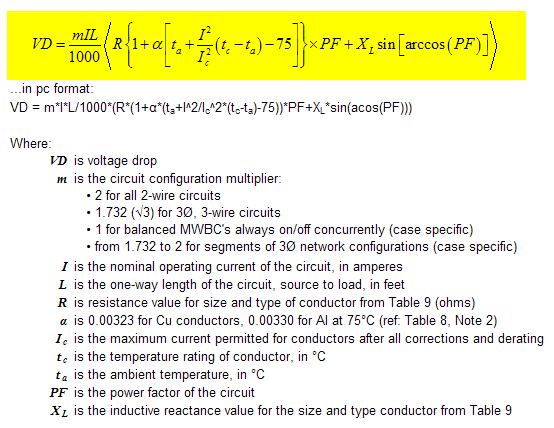You are using an out of date browser. It may not display this or other websites correctly.
You should upgrade or use an alternative browser.
You should upgrade or use an alternative browser.
Voltage Drop Calculation
- Thread starter Mike NY
- Start date
- Status
- Not open for further replies.
- Location
- Logan, Utah
tlaidman
Member
- Location
- Cleveland Ohio
there are 2 formulas for voltage drop
single phase VD=2K*L*I/CM
3 phase VD= 1.732*K*L*I/CM
K=either 10.4 or 12.9 depending on who you believe
L= length of wire
I= current
CM=circular mils of wire
single phase VD=2K*L*I/CM
3 phase VD= 1.732*K*L*I/CM
K=either 10.4 or 12.9 depending on who you believe
L= length of wire
I= current
CM=circular mils of wire
jtester
Senior Member
- Location
- Las Cruces N.M.
Mike NY said:Could someone give the formula for voltage drop calculation. 600MCM, TW insulation, length is roughly 600', 400A, and 3 phase 208v. Having a major mind fart.
E=IxZ
Where I=400 amps and Z=.040x.6 for copper in a PVC conduit for 600 feet
I come up with 9.6 volts drop to neutral or 8%.
Jim T
Isn't that a bit undersized for 400A?Mike NY said:...600MCM, TW insulation...400A...
blue spark
Senior Member
- Location
- MN
ortlaidman said:there are 2 formulas for voltage drop
single phase VD=2K*L*I/CM
3 phase VD= 1.732*K*L*I/CM
K=either 10.4 or 12.9 depending on who you believe
L= length of wire
I= current
CM=circular mils of wire
1.732*R*I*L/1000 when K isn't given.
stevearne
Senior Member
- Location
- Rapid City, SD
240.4(B) allows the next standard size overcurrent device when sizing protection for under 800ASmart $ said:Isn't that a bit undersized for 400A?
stevearne
Senior Member
- Location
- Rapid City, SD
The K value is determined by the type of material (copper or aluminum) and the temperature. the 10.4 (or 10.8?)value is probably based on 60 degrees C and is what we were taught years ago.tlaidman said:there are 2 formulas for voltage drop
single phase VD=2K*L*I/CM
3 phase VD= 1.732*K*L*I/CM
K=either 10.4 or 12.9 depending on who you believe
L= length of wire
I= current
CM=circular mils of wire
The NEC now uses 75 degrees C for the resistance values of Ch 9 Table 8, so that is what we base the K value on. Using 75 degrees C, the K value should be 12.9 for copper 21.2 for aluminum. These values are actually the resistance in ohms for a conductor of 1000 cmils, 1000 ft long at 75 degrees C.
-- note that the length of the wire is the distance ONE WAY using the formula method.
Last edited:
When determining voltage drop you use actual or max conductor amperes... not the OCPD rating. 400A exceeds the ampacity of TW 600 kcmil copper conductors, even after ambient temperature correction to 21-25?C.stevearne said:240.4(B) allows the next standard size overcurrent device when sizing protection for under 800A
The problem with calculating VD that way is that the formula assumes the current on the conductor will cause the conductor's temperature to be 75?C. Most often, that is simply not so. There is no adjustment in the formula for the temperature of the conductor, no adjustment for the ambient temperature, and no adjustment for the power factor of the circuit. If we were to include these adjustments, the formula would look like this:stevearne said:The K value is determined by the type of material (copper or aluminum) and the temperature. the 10.4 (or 10.8?)value is probably based on 60 degrees C and is what we were taught years ago.
The NEC now uses 75 degrees C for the resistance values of Ch 9 Table 8, so that is what we base the K value on. Using 75 degrees C, the K value should be 12.9 for copper 21.2 for aluminum. These values are actually the resistance in ohms for a conductor of 1000 cmils, 1000 ft long at 75 degrees C.

stevearne
Senior Member
- Location
- Rapid City, SD
You are absolutely right that I = the actual load of the circuit for voltage drop. I should have looked back at the original post to see that 400A was the load.Smart $ said:When determining voltage drop you use actual or max conductor amperes... not the OCPD rating. 400A exceeds the ampacity of TW 600 kcmil copper conductors, even after ambient temperature correction to 21-25?C.
- Status
- Not open for further replies.

